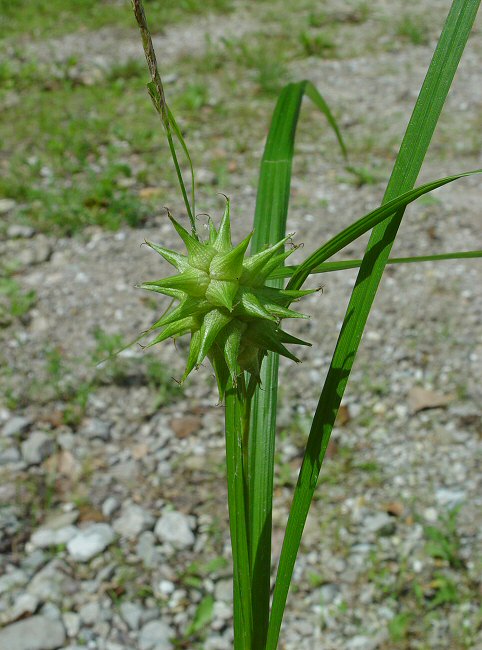Carex grayi J. Carey
Globe Sedge

Native
CC = 7
CW = -3
MOC = 58
© DETenaglia
Carex grayi J. CareyGlobe Sedge | |
 |
Native CC = 7 CW = -3 MOC = 58 |
© DETenaglia |
|
Family - Cyperaceae Habit - Monoecious sedge, lacking rhizomes and forming dense clumps. Stems - Vegetative stems generally well developed, leafy. Flowering stems 1 to few per tuft, 25-90 cm long, somewhat roughened on the angles near the tip, reddish purple at the base. Leaves - Leaf blades 10-35 cm long, 4-11 mm wide, green to light green. Leaf sheaths concave at the tip, the ligule wider than long and U-shaped, the uppermost leaf (not a bract subtending a spike) with the sheath lacking or up to 1.5 cm long.
Inflorescence - Short to somewhat elongate, with the terminal spike staminate, rarely with a second, staminate spike, and 1-5 lateral, pistillate spikes.
Spikes - Staminate spike 5-55 mm long, 1-4 mm wide, nearly sessile to long-stalked, the stalk shorter than to less commonly longer than the uppermost pistillate spike. Staminate scales 4-6 mm long, lanceolate to oblong-ovate, rounded or tapered to a point at the tip, tan to light orangish brown, with a green midrib and lighter margins. Pistillate spikes 1-2, 25-42 mm long, 26-41 mm wide, globose, with 6-35 densely clustered perigynia spreading in all directions. Pistillate scales 4-11 mm long, ovate to broadly ovate, rounded or tapered to a point or short awn at the tip, straw-colored to nearly white, with a green midrib and white margins.
Perigynia - Perigynia 12.5-20.0 mm long, inflated, circular to obscurely trigonous in cross-section, ovate-elliptic in outline, tapered to a conical beak with 2 narrow, stiff, spreading to ascending teeth 0.5-3.0 mm long at the tip, green to dark green, dull, glabrous or short-hairy, the base angled. Styles straight or contorted in the lower half. Fruits with the main body 3.3-4.8 mm long, longer than wide, elliptic to obovate in outline, widest at or above the middle, the angles not thickened, the sides slightly convex.
Flowering - May - October. Habitat - Swamps, bottomland forests, streambanks. Origin - Native to the U.S. Lookalikes - C. intumescens. Other info. - This distinctive sedge is probably the easiest of Missouri's sedges to recognize on sight. It is sometimes called "Sputnik sedge" after a fanciful resemblance of the pistillate spike to an orbiting satellite. It is Missouri's only sedge with globose spikes and (relatively) gigantic perigynia. The lookalike C. intumescens can appear somewhat similar, but has fewer perigynia which point generally forward instead of in all directions, and which are arranged in less globose spikes. The lookalike is also confined mostly to the Bootheel region. C. grayi occurs across most of Missouri except for the Ozark region and the northwestern corner of the state. Photographs taken off the MKT Trail, Columbia, MO., 5-11-04, and along the shores of the Missouri River, Boone County, MO., 5-29-04 (DETenaglia); also at Robertsville State Park, Franklin County, MO, 6-9-2020 (SRTurner). |